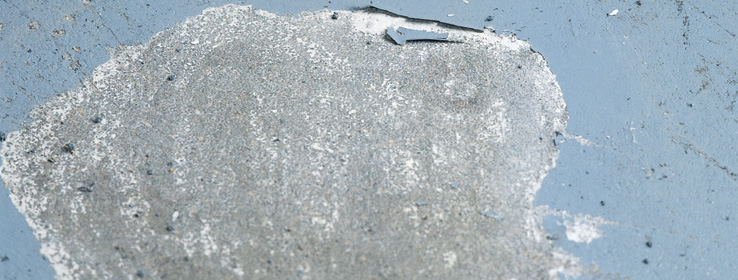DESCRIPTION
A loss of adhesion a paint coating from concrete flooring resulting in flaking and peeling of the paint coating.
POSSIBLE CAUSE
Inappropriate coating for the amount or type of wear and exposure the floor will receive.
Poor adhesion, which often occurs if hardeners are added to concrete.
Efflorescence, which occurs as water migrates through concrete and leaches alkali.
Presence of grease, oil, wax, and dirt tend to soak in and are difficult to remove from concrete.
Moisture seeping through concrete floors in basements, especially when floors are laid on-grade without a moisture barrier.
Aged concrete floor, which may crumble and take the paint film with it.
Application of an oil-based floor finish is applied to a bare, unetched, uncured concrete floor. When oil resins contained in the floor coating come in contact with the alkaline concrete surface, they combine, react with one another, and form a soap film between the concrete surface and the oil coating. This reaction is called saponification and results in extremely poor adhesion and softness of the alkyd (e.g. oil-based) coating.
SOLUTION
Concrete must be free of moisture as much as possible (moisture seldom drops below 15% in concrete). Test for moisture or dampness by taping the edges of a 2' x 2' plastic sheet on the bare surface (an asphalt tile or other moisture-impervious material will also do), sealing all of the edges. After 48 hours, inspect for moisture, discoloration, or condensation on the concrete or the underside of the plastic. If moisture is present, the source must be located and the cause corrected prior to painting.
Remove all surface contamination by washing with ProClean® Professional Prep Wash Cleaner or other appropriate cleaner, rinse thoroughly, and allow to dry.
Scrape and sand existing peeled or checked paint to a sound surface. Sand glossy surfaces dull.
If needed, remove all form release agents, curing compounds, salts, efflorescence, laitance, and other foreign matter by sandblasting, shotblasting, mechanical scarification, or suitable chemical means (refer to ASTM D4260). Rinse thoroughly to achieve a final pH between 7.0 and 10.0. Allow to dry thoroughly prior to coating.
Surfaces must offer sufficient profile to achieve adequate adhesion. If the concrete feels like 120-grit sandpaper, the profile is enough for a coating to bond properly with the concrete. If the surface is too smooth, etch the surface with H&C® Concrete Etching Solution first, following label directions. For very smooth surfaces (troweled surfaces with no porosity), use H&C® Concrete Etching Solution at full strength. For smooth-troweled concrete with some porosity, 1 part H&C® Concrete Etching Solution to 2 parts water should be used. Rough-textured concrete does not need to be etched. Do not etch painted surfaces.
Etching solution and cleaning residue will collect in low spots. It is recommended that the floor be vacuumed to remove any remaining fluids.
If surface deterioration presents an unacceptably rough surface, ArmorSeal 5020 Floor Resurfacer is recommended to patch and resurface damaged concrete. Fill all cracks, voids, and bugholes with ArmorSeal Crack Filler.
Contact your local Sherwin-Williams® representative or store for the proper coating recommendation.




